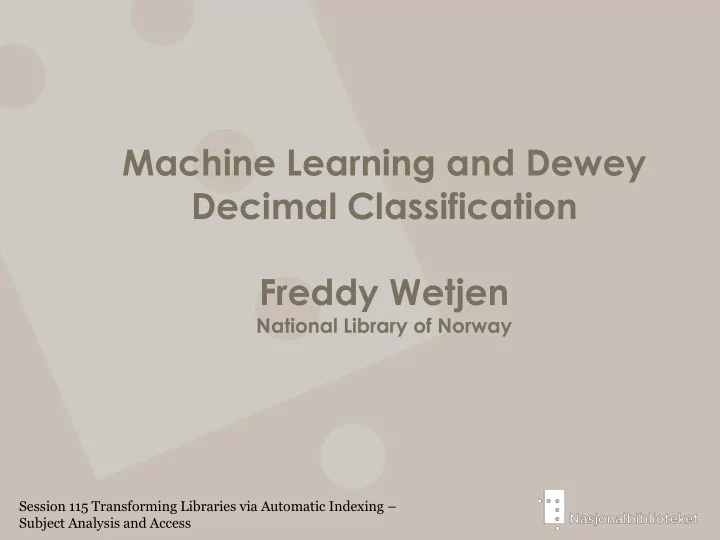

Machine Learning and Dewey Decimal Classification Freddy Wetjen National Library of Norway Session 115 Transforming Libraries via Automatic Indexing – Subject Analysis and Access
Outline Machine learning and Dewey classification attempts in the National Library of Norway (NLN) • Why? • How ? • Results
What is Machine Learning at NLN?
• NLN has a machine learning lab • Hands-on experiences with AI technology • We work with AI and ML on different fields and media types • AI and ML are tested with all major media types (Film,photo,text,sound..) • Used for categorization, classification,recognition and discovery • Build small applications to show the power of machine learning • Identify strengths and weaknesses of the technology • Close cooperation with Stanford University Library
AI is not a new technology and certainly not a new way of problem solving. Machine learning models have improved much in the last five years The concept of manual knowledge modelling in AI systems is almost gone Instead, we have introduced the data science concept into machine learning and AI; we let the system build its own knowledge model although carefully selecting the «learning material». AI methods gets widely available through open frameworks such as Tensorflow,Pytorch, gensim etc. Increasing demand for data science specialists and programmers with knowledge and understanding of ML algorithms
From programs to rules to learning • Tradition in programming – If-then-else – Control and precision – Deterministic • Machine Learning – Learning from example data – Learning as an automatized task – Approximate – Non deterministic
«Data to learn from» Digital Meta- content data «Training» Learning «Usage with knowledge Use building»
Experiments, principles, practice
Prerequisites • Computing power – Less power, more time • Software – Mature open-source community • Training and test data – Supervised learning requires high quality labeled data – Digital content with metadata (libraries) • Skills in ML
Why ML at NLN?
NLN going digital - ambition • Mass digitization – The complete collection is supposed to be digitized (2006) – Most of the published books close to 50 % of all newspaper editions are digitized • Digital library – A complete library at the user’s fingertips – Search in everything, access to everything – UX improvements wanted
NLN is the perfect playground • Massive digital content in all forms • Good metadata for some data • User data (user behaviour) • Good domain understanding, high level of digital skills • Mature digitalisation technology
ML helps us being a library USE WISDOM UNDERSTANDING KNOWLEDGE INFORMATION DATA
Various experiments carried out • Grouping of litterature – Poetry, Cooking, Sci-Fi, Crime … • Identifying grey litterature • Speech to text • Analyzing still images and moving images (video), identifying objects • Image and video search and identification • Finding persons, places, organizations and more in text – and relationships between those • Speaker identification • Sound fingerprinting
Ambition: Alternative workflows Lorem ipsum dolor sit amet, Lorem ipsum dolor sit amet, Lorem ipsum dolor sit amet, no sit summo legere no sit summo legere no sit summo legere platonem, aeque perpetua platonem, aeque perpetua platonem, aeque perpetua sadipscing ei sed. His eu sadipscing ei sed. His eu sadipscing ei sed. His eu odio dico inciderint, odio dico inciderint, odio dico inciderint, imperdiet percipitur at per, imperdiet percipitur at per, imperdiet percipitur at per, quo et nihil … quo et nihil … quo et nihil … DDC DDC producer producer DDC DDC /catalog /catalog DDC /catalog
Dewey Decimal Classification experiments with their results
Using NORART as an example .. • NORART is a hub for access to published Nordic and Norwegian scientific articles • All articles have dewey classification assigned • Librarians are classifying all articles • Time consuming intellectual work • Carefully selecting publications of particular dewey classification to create train and test sets. • Working with carefully selected data and testing • Design of algorithms, parameters, data sets
Approach • Define scope for DDC – Classes, layers • Define training set – Size – Content (articles) – Existing metadata • Define test set – Size – Content (articles) – Existing metadata
Constraints • Limited no of DDC classes • Only 3, 4, 5 and 6 levels • More levels, less content per class • Focus example: Automatic DDC identification of NORART scientific articles and content terms
Example of learning/test definition L=3 50 100 200 400 Test size 10 20 30 40 Real content Yes Yes Yes Yes only Size of 5/10 10/20 20/40 40/80 artifical content
User perspective: Dewey in NORART • Nancy, could you please classify this article by 3, 4, 5 and 6 digits Dewey? – Norart as metadata – Born digital content, artificial articles – 70-92% (100) precision
Btw: Artificial documents • Used to improve the size of the training set • «New» articles are produced by interchanging words between articles with the same DDC, or by replacing words/terms with synonyms • Care taken not to insert bias; Not an easy task to avoid. Using artificial documents has its downside
Improvements • Reinforced learning – Continous improvement – Corrections from skilled librarians – Use of user behaviour • Change of models
Conclusions • Supervised learning on text and metadata from libraries works • Relatively high precision in prediction of DDC • Artificial documents helps • Need for more training data • Overall, modern ML will play a major role in digital libraries
Thanks for listening freddy.wetjen@nb.no
Recommend
More recommend